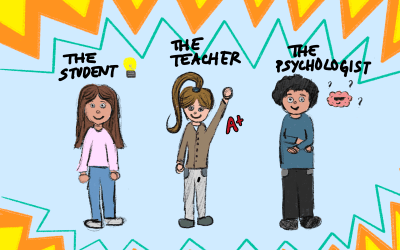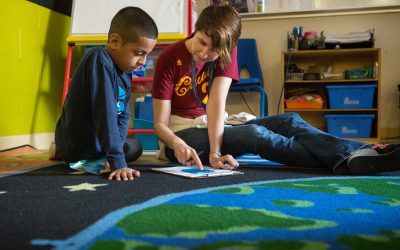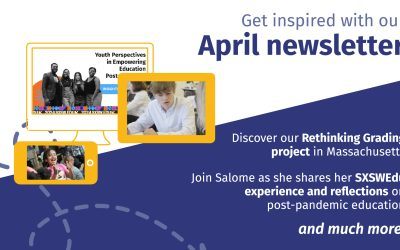Can you imagine walking into a library, in search of a particular book, to find the library has no classification system in place? Or what about arriving at the airport, passing through security, and discovering there are no flight information display systems or gate identification numbers? What if cities and towns had no street signs, or maps? How would we find our way?
Let’s extend the analogy to K-12 curriculum. How well is K-12 curriculum designed to support students in understanding and navigating their own learning process? I don’t mean the tech-enabled “playlist” approach of self-paced, totally linear, content-coverage-driven tasks that often resemble digital worksheets. I mean the thinking processes – cognitive and metacognitive – that help us learn deeply, and lead our own learning process. How can we make these more visible in our curriculum, so that they can be taught explicitly, practiced routinely with feedback, and internalized by learners?
Curriculum should not be designed to reinforce teacher-dependency. Curriculum should be designed to build learner agency. This is at the heart of a student-centered, competency-based approach to education. And learner agency, as we know, is not an on-off switch. It’s a developmental process, just like learning how to walk. So how can we build curriculum in a way that makes complex thinking processes transparent to learners, and that also is designed to support learners on their developmental journey through a unit, a course, or a multi-year progression?
In this blog post, we’d like to introduce to you a visual framework, The Competency-based Learning Cycle, that we’ve been using with folks across the country (and beyond!) to support educators in making sense of, and designing learning experiences for, Mastery-based (or Competency-based) Learning. One of my dear friends who leads the Mastery Education Network in Idaho, who is also a seasoned veteran teacher and school leader, said to me upon first seeing this framework, “I can’t tell you how much I wish I had seen this 30 years ago! This is a missing piece.” And that’s where I began to think this might be a helpful resource for educators.
Granted, it’s one small piece of a much larger, and very complex teaching-and-learning puzzle, but arguably an important piece nonetheless. The purpose of the Competency-based Learning Cycle is to:
- Help instructional teams develop a shared conceptual understanding of the learning process
- Guide curriculum design that is grounded in the learning sciences
- Focus instructional planning on understanding and responding to individual learner needs, with high attention to appropriate scaffolding to support high-order thinking
- Provide a patterned structure that helps learners visualize and navigate their own learning process, and ideally, curriculum that’s designed to support it
Before we dig into this, let me super clear: we have no credit to take for the intellectual ideas that undergird this framework. It is the rich bodies of research, across disciplines and over multiple decades (See Sources of Inspiration below), carried out by other very smart and curious people, who have made this simple visual synthesis possible. We’ve just stitched together a few concentric circles to helps folks connect the dots, so to speak. You be the judge on whether or not this is helpful in your contexts. We’d love to hear what you think. OK, let’s get to it.
What is the Competency-based Learning Cycle?
How do airplanes fly?
Why do countries go to war?
How can we build a healthier community?
What makes relationships last?
How safe is my tap water?
Why are men paid more money than women for the same job?
How do diseases spread?
What can immigrant journeys teach us about the world?
Will the world run out of food?
Will gun regulation result in more or less freedom for Americans?
Am I on track for a healthy life?
Humans are full of great questions. In the words of Edmond Burke, “The first and the simplest emotion which we discover in the human mind, is curiosity.” Our curiosities lead us, compel us, to engage in an inquiry process that helps us build knowledge and make meaning of our world. Through this process, we have a golden opportunity as educators to help learners develop the critical skills, strategies, and know-how to become competent and critical learners and thinkers. In order to do that, we first must make these invisible thinking and learning processes visible. That’s what the Learning Cycle is all about.
In a nutshell, the Competency-based Learning Cycle is a visual framework that illustrates the cognitive and metacognitive processes that help learners develop competency with practice and feedback, as they work and learn in increasingly challenging contexts. We wrote about this Learning Cycle in a recent publication for iNACOL and CompetencyWorks, Meeting Students Where They Are, though we’ve made some slight adjustments since then. Let’s take a look:
The Outer Cycle
The “outer circle” represents the four major stages of a competency-based project or unit of study through which learners explore a compelling question or issue. Let me add emphasis here: I believe interest-driven inquiry, on grounds of equity, should be a normative part of the educational experience for all learners, and therefore a dominant feature of our curriculum. The Learning Cycle structures this inquiry process, and culminates in a product or performance that demonstrates learners ability to apply their developing skills and knowledge to an authentic task that is in some way a response to the compelling question. Though not feasibly with every unit of study, learners do have regular opportunities to engage an authentic audience, and finally, to reflect on their learning through the entire process. This arc spans 3-8 weeks, give or take, depending on scope and complexity. For early elementary, units may be shorter in length to support high-volume production early on.
In competency-based curriculum, a specific competency (e.g., Reading Critically, Designing Solutions, Investigating Through Inquiry, Taking Civic Action) is identified as the target competency that learners will focus on through their Learning Cycle journey, and that they’ll show evidence of in their final product or performance. In a personalized, competency-based learning system, learners may have the flexibility to determine the specific competency they will focus on, based on their portfolio requirements and needs. This gets fun! But I digress.
The Inner Cycle
The “inner circle” structures daily learning experiences. It reflects a “gradual release of responsibility” approach (Pearson & Gallagher, 1983), with adaptations for mathematics instruction to ensure productive struggle (Kapur, 2014) precedes explicit instruction. These learning experiences are purposefully and directly connected to the larger arc (outer circle), such that successful, recursive movement through this inner cycle enables progress through the four stages of the unit. For learners – especially older learners with acute bullshit radars, like Jeff Bliss – it’s important to be really explicit about how the daily learning is working in service of the bigger-picture outcome. And of course, we need to be sure that it does! As a general rule of thumb, there should always be a through-line between the learning experiences of today, and the bigger outcome we’re working toward. To see this in action, check out these Out of the Gate unit projects that reDesigners helped to create, which are built around a modified Learning Cycle. There are 18 standards-aligned projects in total, spanning grade bands and disciplines, and they are all open source and freely available. Cheers to PBLWorks!
It’s also important- and this is once you’ve got the classroom structures, norms, and culture in place to support this- that learners have the opportunity to make meaningful choices about what they need in order to be able to progress from one stage to the next (or progress through stepping stones within a stage). This builds engagement, and if coupled with ongoing opportunities for reflection and coaching (specifically related to student decision-making), will help develop learner agency.
Case in point: I had the opportunity last year to work with a high school social studies teacher who decided to totally reconfigure her class time, and move from lecture and note-taking, to mini-lessons that students could sign up for. Each mini-lesson was explicitly tied to specific skills that were necessary for the unit project. She was so thrilled, and frankly surprised, as she watched her teenage students actually sign up for mini-lessons, based on their self-assessment of what they needed help on. If someone chose not to participate, but then bombed the formative assessment, it was a perfect opportunity to touch base and coach the learner on their decision-making.
Here’s a quick excerpt from our closing reflection of that particular coaching cycle:
Me: What was your experience [like] of shifting the lesson to the choice-based mini-lesson? Did that change any dynamic for you with the kids in any way?
Ms. Oliver: Well, I loved it. I loved it so much that I do it all the time with them now. Now, before they walk in, there’s sign up sheets at the door where they have to sign up for a mini lesson slot. It’s currently, everybody has to attend a mini lesson, and we might only do one topic of that mini lesson, but if nothing else, it’s just that small group dynamic is giving me more access to the students. That’s really helpful. Yes, that has been really great.
Me: What do you think changed for them, in terms of their experience as learners, in that mini-lesson setting?
Ms. Oliver: I think they were more aware of their time, they are more aware of their time when I do mini lessons because they’re like, okay, well, I gotta get to that mini lesson, but I also have to finish this work. So I actually think it does push them a little bit harder. Which is nice. I’ll call them over and they come over and sit down and engage for, even if it’s just a few minutes. I think they see more accountability in that, they’re held to a standard now, right? I’m asking them to be present with me in this period of time, even if it’s only five minutes. Yeah, I also really liked it because I thought it gave them choice and I felt like I wasn’t, I didn’t have to teach people things that they weren’t gonna just, they weren’t gonna use in the next few minutes. Basically, right? All of the stuff we worked on was stuff that they were about to do, that was super applicable to the work that they were required to do. I liked that aspect of it (Interview, 2/28/18).
Breaking it down
So what exactly happens at each stage of the learning cycle, specifically, at both the lesson and unit level? What do you really mean when you say “Make Meaning,” and “Investigate?” In this brief slide set, you can see specific descriptions of each stage of the learning cycle. You’ll note that the explanations for the “Make Meaning” and “Investigate” stages differ depending on whether you are describing them at the lesson/lesson series level or unit/project level. Have a look:
Introduction to reDesign’s Learning Cycle
There’s a lot more to say (and do!) with the Learning Cycle, but we’ll leave it here for now and we invite you to share your thoughts in the Comment box below. Look out for future posts on the Competency-based Learning Cycle in action. See you then.
Sources of Inspiration
Bandura, A. (1977). Social learning theory. Englewood Cliffs, NJ: Prentice-Hall.
Bransford, J., National Research Council (U.S.)., & National Research Council (U.S.). (2000). How people learn: Brain, mind, experience, and school. Washington, D.C: National Academy Press.
Brown, J.S., Collins, A., and Duguid, P (1989). “Situated Cognition and the Culture of Learning.” Educational Researcher, 18(l), 32-42.
Bybee, R., Taylor, J. et al. (2006). The BSCS 5E instructional model: Origins and effectiveness. Colorado Springs, CO: BSCS.
Collins, A., Brown, J., and Holum, A (1991). “Cognitive Apprenticeship: Making Thinking Visible.” American Educator, 6(11), 38-46.
Collins, A., and Stevens, A.L. (1983). “A Cognitive Theory of Interactive Teaching.” In C.M. Reigeluth (Ed.), Instructional Design Theories and Models: An Overview. Hillsdale, NJ: Erlbaum.
Dewey, J. (1938). Experience and education. New York: Macmillan.
Dewey, J. (1933). How we think: A restatement of the relation of reflective thinking to the educative process. Boston, New York [etc.]: D.C. Heath and company.
Duke, N. K., & Pearson, P. D. (2002). Effective practices for developing reading comprehension. In A. E. Farstup & S. J. Samuels (Eds.), What research has to say about reading instruction (pp. 205–242). Newark, DE: International Reading Association.
Fisher, D., & Frey, N. (2008). Better learning through structured teaching: A framework for the gradual release of responsibility. Alexandria, VA: ASCD.
Gay, G. (2010). Culturally responsive teaching: Theory, research, and practice. New York: Teachers College.
Kapur, M. (2008). Productive failure. Cognition and Instruction, 26(3), 379-424.
King, B., Newmann, F., and Carmichael, D. (2009). “Authentic Intellectual Work: Common Standards for Teaching Social Studies.” Social Education, 73(1), 43-49.
Palincsar, A.S. (1986). “Metacognitive Strategy Instruction.” Exceptional Children, 53, 118-125.
Palincsar, A.S. (1987). “Reciprocal Teaching.” Instructor, XCVI No. 2, 5-60.
Pearson, P. D., & Gallagher, G. (1983). The gradual release of responsibility model of instruction.Contemporary Educational Psychology, 8, 112–123
Piaget, J. (1952). The origins of intelligence in children. New York: W. W. Norton.
Vygotsky, L. S. (1978). Mind in society. (M. Cole, Trans.). Cambridge, MA: Harvard University Press.
Winne, P. H., & Perry, N. E. (2000). Measuring self-regulated learning. In M. Boekaerts, P. R. Pintrich, & M. Zeidner (Eds.), Handbook of self-regulation (pp. 531-566). San Diego, CA, US: Academic Press.
Wood, D., Bruner, J. S., & Ross, G. (1976). The role of tutoring and problem solving. Journal of Child Psychology and Psychiatry, 17, 89–100.
Join the community!
Sign up to receive our newsletter, access best-of educational resources, and stay in the know on upcoming events and learning opportunities. We hope to see you soon!





